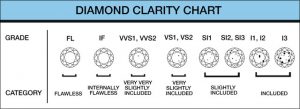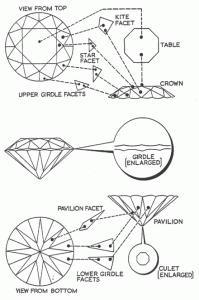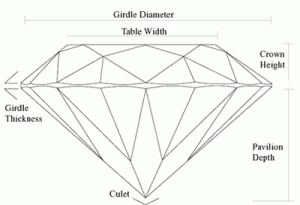Diamond Color, Clarity, Carat and Anatomy Charts
Diamond Color Chart
When we speak of grading diamond color we mean deciding by which amount the diamond’s “body color” deviates from the whitest possible (water like colorless) color.

It is difficult to see the subtle differences between one color grade to the next. When grading diamonds for color it is important to have a Master Color Diamond Set (pre-graded diamonds usually E-G-I-J) to compare the diamond being graded. Also a controlled lighting environment is helpful for accuracy. Diamonds must always be graded unset to ensure grading accuracy.
Diamond Clarity Chart / Scale
Most diamonds aren’t perfect and include blemishes, inclusions, or feathers naturally created through time. The clarity of a diamond refers to how clean or clear a diamond is internally. The cleaner the diamond, the higher the price. The clarity scale was developed to have a universal rating system of diamonds imperfections.

The diamond clarity tool on James Allen is a fantastic way to visualize how different clarity grades might look in real life under the jewelers loupe.
Diamond Carat Weight Chart
Diamonds are measured by carat weight, and not size. Two diamonds having the same carat weight could have different millimeter sizes because a diamond is three dimensional meaning length, width, and depth. The scale below is a comparison of the sizes based upon carat weight with cutting percentages being the same.

Diamond Shapes
To most people, the word ‘diamond’ conjures images of the ever-popular and always classic round stone. Going this route is almost guaranteed to get you the reaction you’re looking for, but you can also choose one of the more unique shapes collectively referred to as ‘fancy cuts’.
Shape does not affect the quality of the stone. If it is well cut its brilliance and value will endure no matter what. The shape of the rough diamond crystal usually dictates the shape of the stone. All are cut for maximum fire and brilliance, but facet shape varies with the cut and as a result, filters light differently. Additionally, some designs are more suited to a particular shape.

Diamond Cut
The cutting of a diamond and its proportioning, called “Make” in the jewelry trade, are of extreme importance. The fire (variety and concentration of the prismatic colors emitted) and the brilliance (liveliness or sparkle, of the diamond) directly depend on the proper cutting and proportioning of the diamond. Obtaining the optimum Table and Depth proportions are critical for superior diamonds. “The Magic is in the Make!”


Diamond Anatomy
To obtain a “High Performance” diamond it is helpful to have a clear understanding of a Diamond’s Anatomy. With a clear understanding of the Diamond’s Anatomy and the proper proporations for Ideal Makes one can be assured a “High Performance” diamond will be yours.
